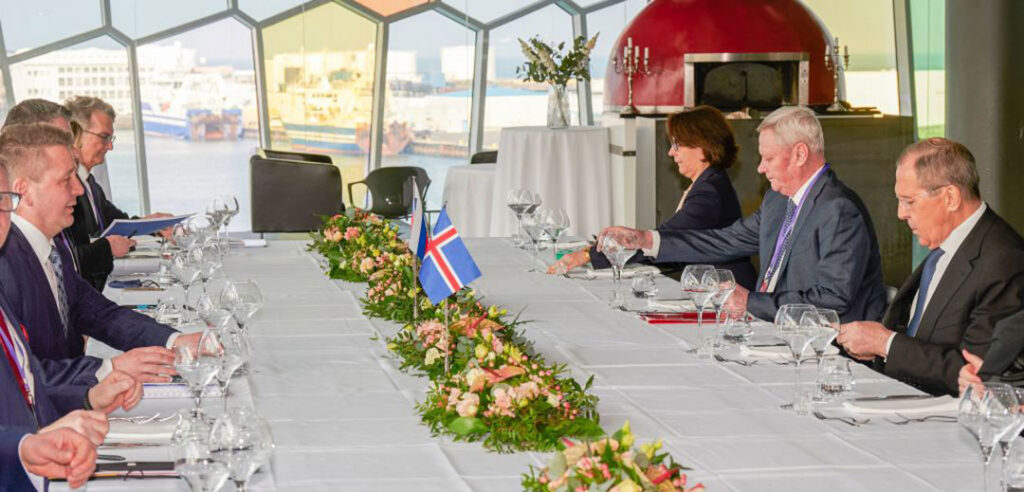The Arctic Council, shown here in 2021, has mostly halted cooperative work after the Russian invasion of Ukraine in 2022. That action has sparked growing military and political cohesion in Scandinavia. AFP/GETTY IMAGES
THE WATCH STAFF
The Russian invasion of Ukraine has strengthened NATO resolve and integration in many ways, but perhaps the most significant has been an emerging unified Nordic military strategy to deter Russia, especially in the Arctic. In the last two years, Denmark, Finland and Sweden have all signed defense agreements with the U.S., and Norway expanded its previous arrangement, opening dozens of military bases and facilities in the Arctic. Additionally, Finland and Sweden have joined NATO.
These dramatic changes from a region that has mostly hewed to a nonaligned diplomatic stance since early in the Cold War came into sharp relief at a January 2024 defense conference in Salen, Sweden. At the conference, Micael Býden, supreme commander of the Swedish Armed Forces, delivered a presentation that included shocking images from the Ukrainian front lines overlaid on a backdrop of a snow-covered Swedish landscape, according to Foreign Policy, a global affairs magazine. “Do you think this could be Sweden?” he asked. The Swedish response is now emphatic. Consider comments from Swedish Prime Minster Ulf Kristersson at the same event where he urged Swedes to prepare to defend their country “with weapons in hand and our lives on the line,” according to Foreign Policy.
The northern European embrace of NATO and closer collaboration with the U.S. has major implications for the Arctic and northern approaches to the U.S. homeland. Seven of the eight Arctic nations are now NATO members as a changing climate continues to create new shipping routes and opportunities for the extraction of valuable minerals. The Arctic’s strategic value will only increase, accelerating the need for a strong defense of the international rules-based order that has maintained peace in the region until now. “The increasing competition and militarization in the Arctic region … is worrying,” NATO Military Committee Chairman Adm. Rob Bauer said in an October 2023 speech at the Arctic Circle Assembly in Reykjavik, Iceland. “We must be prepared for military conflicts arising in the Arctic.”
The Russian invasion of Ukraine has dissolved longstanding international agreements between Russia and the seven other Arctic states — Canada, Denmark, Finland, Iceland, Norway, Sweden and the U.S. — on safety, environmental and scientific issues. The Arctic Council, a forum for the eight nations, suspended talks in 2022, although some limited technical exchanges were resumed in 2023. Russia also left the Barents Euro-Arctic Council in 2023, saying the other members, Sweden, Norway and Finland, had “paralyzed cooperation,” according to Foreign Policy.
Meanwhile, Russia amended its Arctic policy to upgrade alliances with Brazil, India, the PRC and South Africa on future collaboration in the region. The PRC has stepped up Arctic voyages, ostensibly for scientific purposes, and sent ships along the Northern Sea Route, an Arctic shipping lane that Russia has claimed sovereignty over but that hasn’t been recognized by the international community. “There’s this post-Cold War political idea of ‘Arctic exceptionalism,’ that the north is excepted from developments in global politics,” Rasmus Bertelsen, an expert in Arctic politics at the Arctic University in Tromso, Norway, told Foreign Policy. “The problem is, it’s never been valid.”
The Nordic states have grown closer to one another on defense policy, a trend stretching back more than a decade. In 2009, Denmark, Iceland, Norway and Sweden created a policy of Nordic Defense Cooperation, which tightened interoperability and planning. In 2022, Finland, Norway and Sweden agreed to strengthen their alliance with an Arctic focus. And Denmark, Finland, Norway and Sweden are currently discussing how to formally integrate their air forces.
This new cohesion was demonstrated at the Nordic Response exercise in March, which took place in Scandinavia. The trend is likely to continue. As Danish Defence Minister Troels Lund Poulsen made clear at a security conference in 2023: “We should strengthen the region’s surveillance and look at how our military systems and units can better operate together. This way, the Nordic countries can be responsible for a large area. This will also benefit NATO and the security of Northern Europe.”
The presence of Finland and Sweden at the 2022 NATO summit in Madrid – prior to their accession – prompted Russian President Vladimir Putin to threaten the two nations if they allowed NATO troops or materiel on their soil, saying Russia would create the “same threats” to those nations, according to The Associated Press. Since then, Finland has closed its land border with Russia, the longest in NATO, and both countries have signed defense agreements with the U.S. that allow troops and materiel on their territories. Michael Paul, a senior fellow in security policy at the German Institute for International and Security Affairs, told Foreign Policy that history will reveal this new Nordic alliance as “one of Putin’s greatest mistakes.”

